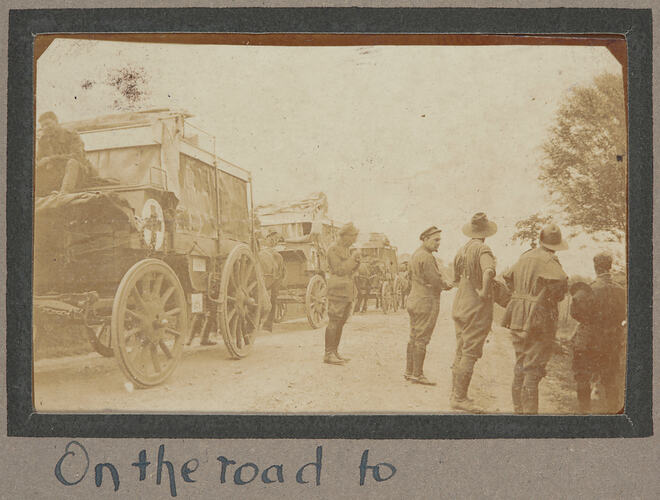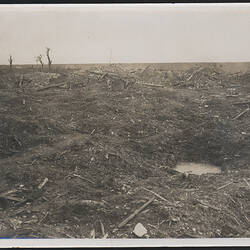Summary
Black and white photographic print depicting a group of horse-drawn ambulances and drivers, temporarily stopped on their way to the French village of Wardrecques. Located in the North of France, Wardrecques sits in the Pas-de-Calais region, 5 kilometres east of St Omer. It has been recorded that the 13th Field Ambulance were in Wardrecques around the 25th of June 1917. The horse drawn ambulances shown in this photograph are that of the Mark VI variety. This wagon could carry 12 sitting patients or six sitting with two men on stretchers. A large water tank was carried beneath the rear step and lockers were situated under the floor to hold medical supplies. Generally, in each field ambulance there was a total of 10 horse-drawn ambulance wagons.
One of 95 black and white and sepia-toned photographs taken in France during World War I, attached to a photograph album. The album includes a few photographs of enemy prisoners, the war cemetery at Warloy, a wrecked German ambulance and images of the local French people. Most photographs are of Albert and surrounds so it would seem probable that most were taken during and after the Battle of the Somme (1916). In addition there are also photographs dated 1917. The photographs were taken by Private John Edward Lord, 13th Field Ambulance, and brought back to Australia by him and compiled in an album at the end of the First World War.
The album is one of many souvenirs brought back to Australia after World War I by Lord, and is part of a larger collection of photograph albums, images, documents and World War I memorabilia donated by Lord to Museum Victoria.
Description of Content
In the left hand side of the image there is a line of four horse drawn field ambulances that stretch into the background. Each field ambulance has a red cross positioned on the side. The first ambulance in the row has a uniformed soldier sitting in the drivers seat but it is difficult to tell if he is holding the reins. In the right hand side of the image there are five soldiers in uniform standing on the road with their backs to the camera.They appear to be observing the line of field ambulances.
Physical Description
Monochrome photograph, mounted in a small, grey photograph album.
Significance
This album appears to have been prepared to 'showcase' the war experiences of John Lord and the photographs associated with these. The album has been very carefully prepared and the quality of the photographs is generally good, in comparison to the album ST40491, also compiled by John Lord, which has a number of photographs which are of poor quality, many photographs removed and written in (mostly) illegible pencil. This suggests this album was most probably compiled after the war, with photographs probably gathered from other photograph albums of Lord's.
The subjects of the photographs are of trenches (both German and Allies), horses, camps, farms, graves and cemeteries, civilians, soldiers, churches and other buildings. Many of the photographs were taken around the town of Albert and are dated 1916 and 1917. From this information we can tell that Lord was involved with the Battle of the Somme when these photographs were taken.
The Battle of the Somme was fought from north of the Somme river between the towns of Albert and Arras. The Battle began on the 1 July and was called off on the 18 November 1916. The Battle of the Somme is famous for the loss of 58,000 British troops (one third of them killed) on the first day of the battle, 1 July 1916, which to this day remains a one-day record.
More Information
-
Collection Names
-
Collecting Areas
-
Acquisition Information
Donation from J. Lord, 1986
-
Place & Date Depicted
-
Photographer
Sergeant John Lord, France, 1916-1917
Image may have been taken by Lord or collected by him for use in this album. -
Format
Photograph, Monochrome
-
Inscriptions
Handwritten in ink on matt directly below photograph: 'On the road to'
-
Classification
-
Category
-
Discipline
-
Type of item
-
Image Dimensions - Photograph
60 mm (Width), 40 mm (Height)
-
Image Dimensions - Photograph album page
195 mm (Width), 145 mm (Height)
-
Keywords
Australian Army, Militaria: Australian, Military Memorabilia, Souvenirs, Wars & Conflicts, World War I, 1914-1918, Making History - War Diaries and Correspondence


